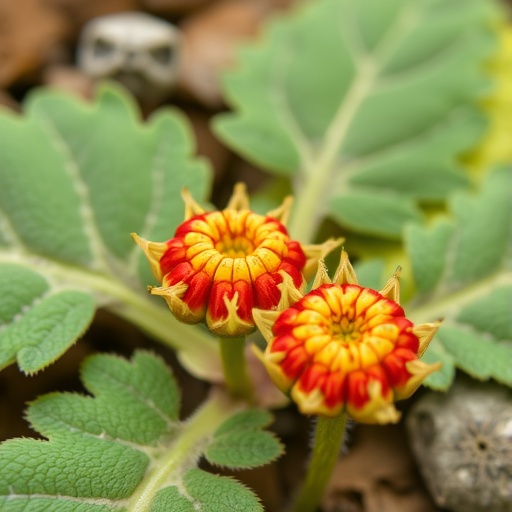In an intriguing development within the field of plant sciences, new research has shed light on the seed surface of a unique plant species, Rheum wittrockii Lundstr., which is native to the diverse flora of Kazakhstan. This study, conducted by S. Dagarova, appears in the latest issue of “Discover Plants.” It deepens our understanding of the intricate features of seeds and may provide insights into the evolutionary adaptations of this species in its natural habitat.
The research reaffirms the importance of understanding seed morphology and its implications for plant germination and establishment, especially in the face of changing environmental conditions. Through meticulous examination, the study highlights how the seed surface structure of Rheum wittrockii may influence its dispersal mechanisms and survival strategies in the diverse ecosystems of Kazakhstan. Seed morphology is critical for various ecological processes, including seed-bank formation, dormancy, and the overall lifecycle of the plant.
Kazakhstan is home to a wealth of biodiversity, providing researchers with the opportunity to explore numerous plant species that have adapted to its unique climate and soil conditions. Within this landscape, Rheum wittrockii emerges as a notable species, possessing distinct attributes that contribute to its survival. The research details how its seed surface characteristics may serve as keys to successful germination in varying microhabitats that Kazakhstan’s flora presents.
Delving into the specifics, the study utilizes advanced imaging techniques to reveal the intricate microstructures present on the seed surface. Utilizing scanning electron microscopy, the research uncovers patterns and textures that are not always visible to the naked eye. These findings suggest that the seed surface of Rheum wittrockii has evolved to optimize its interactions with moisture and microorganisms, which are vital for seed germination and subsequent growth.
Moreover, the research discusses the implications of these findings for ecological restoration and conservation efforts. Understanding the selective advantages conferred by certain seed characteristics can guide conservationists in their strategies for maintaining biodiversity in vulnerable ecosystems. Seed traits that enhance survival and germination success could be crucial in efforts to restore or manage populations of Rheum wittrockii in its natural habitat, especially in light of climate change and habitat loss.
The findings of this study also resonate with broader discussions regarding plant adaptation to environmental stresses. Seeds need to evolve mechanisms to withstand a variety of conditions, such as drought, extreme temperatures, and competition from other plants. By unraveling the secrets of the seed surface structure of Rheum wittrockii, researchers hope to illuminate patterns of adaptation that may apply to other species facing similar environmental challenges.
Seed morphology holds a link not just to ecological interactions but also to successful agricultural practices. Insights gained from the surface features of seeds like those of Rheum wittrockii could provide valuable information for the agricultural community. Strategies informed by ecological principles derived from this research might enhance crop resilience and yield in face of adverse conditions.
In addition, the comprehensive research methodology ensures that the findings are robust and reliable. By employing both morphological and ecological perspectives, the research captures a holistic view of how seed surface traits influence the life cycle of Rheum wittrockii. It also encourages further interdisciplinary studies, uniting plant biology, ecology, and conservation strategies.
This study not only signifies a step forward in botanical research but also reinforces the critical need for continued exploration into the lesser-known plant species that play vital roles in ecosystems. Every plant species, particularly those that are endemic to specific regions like Kazakhstan, has a part to play in ecological networks. Understanding these roles through studies like Dagarova’s paves the way for future explorations into the rich tapestry of plant life.
As scientists build on this foundation of knowledge, there’s potential for these findings to inform future research in related fields, including climate studies and habitat restoration efforts. The implications of this work stretch beyond immediate scientific inquiry, potentially influencing policy-making regarding conservation and biodiversity management.
In summary, the research into the seed surface of Rheum wittrockii marks a significant contribution to botany and ecology and serves as a clarion call for more studies into the diversity of plant species that could reveal critical ecological insights. As we watch for the ongoing developments in plant research, it is clear that the revelations contained within these seed surfaces may paint a bigger picture of resilience in the plant kingdom.
With the increasing emphasis on biodiversity conservation and sustainable practices, studies like this one are timely and essential. They highlight the intersection of detailed ecological research with practical applications that could safeguard our planet’s future. Dagarova’s exploration adds a valuable piece to the puzzle that is our understanding of plant biodiversity, encouraging a renewed appreciation for the myriad forms of life that inhabit our world.
Subject of Research: Seed surface characteristics of Rheum wittrockii from Kazakhstan.
Article Title: Research the seed surface of Rheum wittrockii Lundstr. from the flora of Kazakhstan.
Article References:
Dagarova, S. Research the seed surface of Rheum wittrockii Lundstr. from the flora of Kazakhstan.
Discov. Plants 2, 299 (2025). https://doi.org/10.1007/s44372-025-00383-1
Image Credits: AI Generated
DOI:
Keywords: Seed morphology, Rheum wittrockii, Kazakhstan, ecological adaptation, biodiversity conservation, germination strategies.
Tags: biodiversity in Kazakhstandormancy in plant seedsecological processes of seed banksevolutionary adaptations of plantsimplications of seed characteristics on survival strategiesplant ecology and adaptationplant germination and establishmentresearch on plant sciencesRheum wittrockii seed morphologyseed dispersal mechanismsseed surface structure in Kazakhstanunique plant species of Kazakhstan





